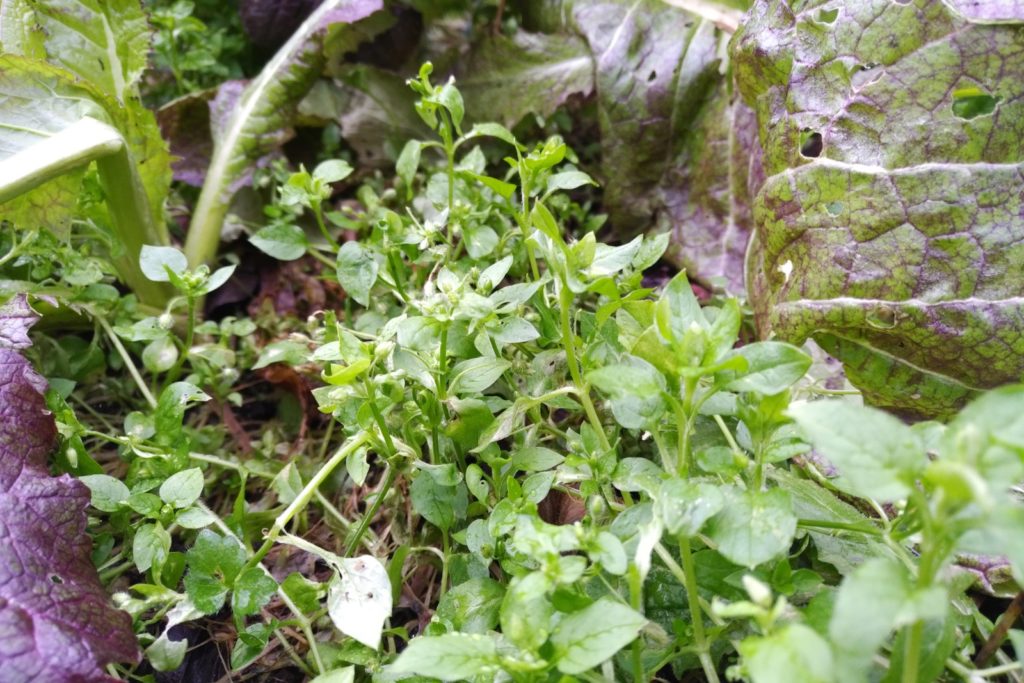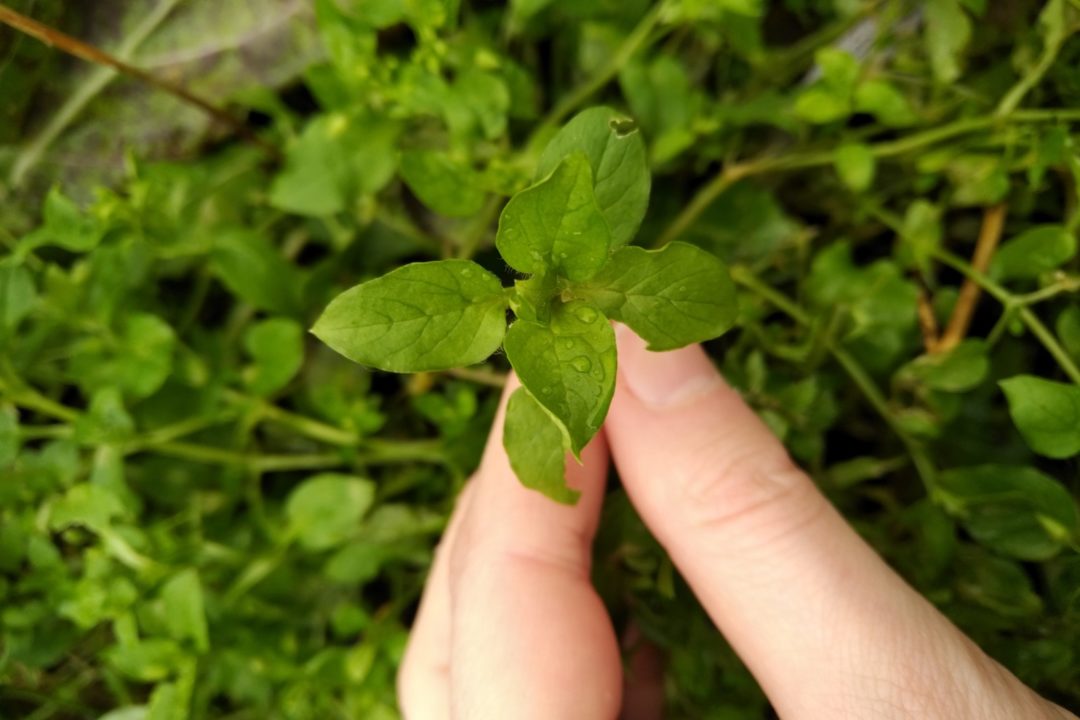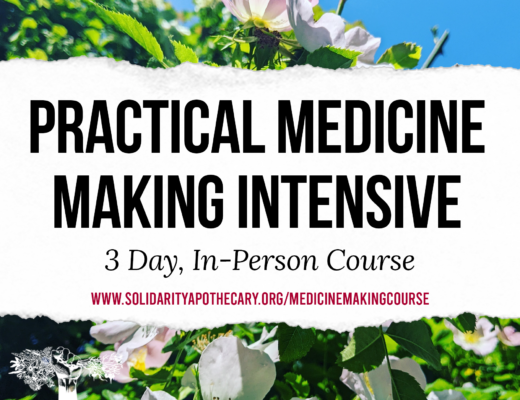Please note these plant profiles are a work in progress. I will always be adding to them as I keep learning about the amazing world of plant medicine.
Botanical Overview
Latin name: Stellaria media
Plant family: Caryophyllaceae
Identification: Small, white, star-like flowers that have 5 petals. A single line of hairs on stems. Low growing, clump-forming from 10-40cm. The herb blooms from March until November, however, in our changing climate I have found it in flower in early January in the garden!
Other species: There are lots of similar chickweeds and stitchworts. Mouse ears (Cerastium spp.) have similar flowers and petals but are uniformly hairy).
Folk names in English: Starweed, fliodh (Irish), cosmopolitan weed, chick wittles, clucken wort, chickney weed, tongue grass, winterweed, satinflower, white birds eye, adder’s mouth, stitchwort and shirt buttons. Stellar means star in Latin, as seen in the gorgeous tiny star-shaped flowers this plant has.
Chemical constituents
- Minerals, including silica, Vitamin C, A, B, Mucilage, Saponins, Fatty acids (1)
Food and nutrition
Chickweed was once sold as a vegetable on the streets of London. It is delicious raw and in salads but can also be added to dishes like tabouli, soups and curries. It can also be made into tasty pesto. Chickweed is great to add to springtime smoothies, and the juice can be frozen in ice cubes for a later date. Chickweed can be very high in aluminium, iron, magnesium, manganese, silicon and zinc. It is also high in calcium, cobalt, phosphorous, potassium, protein, sodium and vitamin A (2). I commonly make chickweed vinegar as vinegar is a great way to extract minerals. You can add the vinegar to salad dressings or even a nice cup of hot water with a slice of lemon.
Ecological role
Chickweed is an annual plant. Ben Averis references chickweed as being found mainly on nutrient-rich soils in disturbed places, waste ground, roadsides, field margins, gardens, stony seashores and seabird cliffs (3). In my experience, chickweed mostly grows on bare soils, where the soil is likely contaminated or low-nutrient, chickweed will be sparse and small. When it’s a garden bed with a soil rich in organic matter, chickweed will grow across like a carpet and be incredibly happy spreading wider and wider. It is a brilliant groundcover before planting out in spring.

Cultivation: I have never grown chickweed from seed, as it always springs up everywhere! If you want to introduce it into your garden then its best directly sowing by seed into the soil, ideally with some compost. Once you have it, it will self-sow.
Folklore: In Hatfield’s Herbal, chickweed is described as a weather forecaster: When its flowers and leaves open fully, good weather can be expected: ‘If it should shut up, the traveller is to put on his greatcoat!’. Apparently, even the seed capsules close up tightly in wet weather (4)
Energetics
- Temperature: Cool
- Moisture: Moist
- Tissue State: Dry/Atrophy, Damp/Stagnation
- Taste: Chickweed tastes very ‘grassy’. It is quite sweet and moist with a very gentle bitterness.
Health challenges supported by Chickweed:
Skin complaints: Externally, chickweed has been used to soothe itches, bits, stings, inflammations, burns, swellings, sunburn, bruises and splinters (5). It can be made into a skin lotion or infused oil for itching and inflamed skin, as well as being made into a poultice. Chickweed has a cooling and drawing action. When made into a poultice, chickweed can be used for its drawing function on boils and absences. Be sure to replace every few hours.
Chickweed can be added to baths and soaks if the area of inflamed skin is extensive. Herbalist Mark Pedersen describes how externally the saponins help solubilise toxins in abscesses and rashes and help them increase the effectiveness of bactericides by increasing the permeability of the cell walls(2).
In their incredible overview of medicinal plant records in Britain and Ireland, David E. Allen and. Gabrielle Hatfield describes the many uses of chickweed referenced historical documents: “By far the commonest of those are in the form of a mat, as a hot and relaxing poultice to reduce swellings, including those of sprains and mumps and other forms of inflammation. Most records share similar uses of chickweed for the skin and inflammation, however, it is also described as a significant remedy for insomnia in Highlands (6).
For inflamed eyes: Chickweed is an ally for eye inflammation including itchiness.
As a cleanser and restorer: Chickweed can also support inflammatory conditions internally. Herbalists Julie Bruton-Seal and Mathew Seal say that saponins work at a cellular level to increase absorption and permeability. What this means is that inflamed organ membranes, as in the liver, kidney and lungs are helped by saponins to absorb healing nutrients, as well as allowing their wastes and blockages to be more easily removed. They continue to say that chickweed works well internally on hot inflammatory problems like gastritis, colitis, congested chest, blocked kidneys and gallbladder, and piles. They say it has an affinity for the lungs, for sore throats, bronchitis, asthma, irritable dry coughs and other respiratory conditions (5). According to herbalist Zoë Hawes, Chickweed can also be dried and made into infusions for rheumatic conditions (7). An Old Wives Tale is that chickweed can be used as an alley to lose weight, which some herbalists attribute to its how it stimulates the metabolism and the break down of fat (8).
Cysts: Chickweed can also be made into a fresh herb tincture. Chickweed tincture, when used for extended periods, can dissolve cysts, especially ovarian cysts (9).
Cautions: Zoë Hawes says do not take chickweed if you have irritation or bleeding of the stomach or intestines as chickweed may aggravate this condition. However, an extreme or excessive intake can cause vomiting or diarrhoea (1).
Combines well with: A really nice salve for eczema, skin rashes and psoriasis can be made with chickweed, chamomile and plantain. Chickweed also combines well with nettle and meadowsweet for rheumatic diseases (7).
Chickweed and the Solidarity Apothecary
Chickweed is incredibly nutritive. The Herbalists without Borders in Bristol group make large quantities of mineral-rich vinegar containing chickweed because it is easy for people to take compared to many teas or infusions that need kettles or pots and pans. It is, therefore, a good plant ally for people who are precarious and vulnerable in terms of nutrition. In prison, I regularly sneaked chickweed back from the prison yard beds into my cell as an extra nutritional boost.
Sources
1. Chickweed monograph, The Plant Medicine School
2. Nutritional Herbology, Mark Pedersen
3. Plants and Habitats, Ben Averis
4. Hatfield’s Herbal, Gabrielle Hatfield
5. Hedgerow Medicine, Julie Bruton-Seal and Mathew Seal
6. Medicinal Plants in Folk Tradition. An ethnobotany of Britain and Ireland, David E. Allen and Gabrielle Hatfield
7. Wild Drugs, Zoë Hawes
8. Chickweed Plant Profile, The Lunar Apothecary Course with Alexis J. Cunningfolk
9. Healing Wise, Susan Weed




